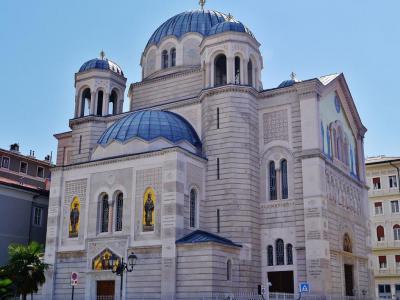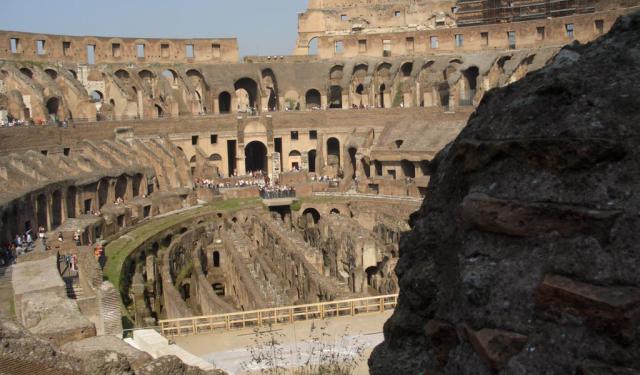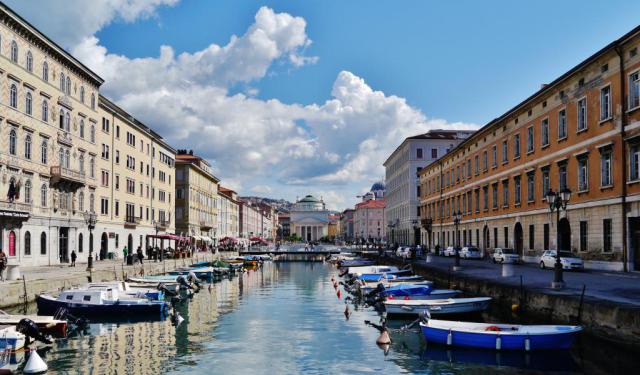
Chiesa Serbo Ortodossa di San Spiridione (Saint Spyridon Church), Trieste
Saint Spyridon, a Serbian Orthodox Church in Trieste, dates from 1751. Empress Maria Theresa of Austria had received a visit from Damaskinos Omiros, a Greek monk from Mount Athos. After that, she allowed the freedom of religion for Orthodox Christians. Thanks to Brother Damaskinos, the first Eastern Orthodox Church was built in the mid-18th century, and it served as a place of worship for both local Serbs and Greeks.
In 1858, the Serbian community in Trieste announced a competition to design a new Church of Saint Spyridon. Architects from Vienna, Venice, Milan, Munich, Rome, and Florence competed. Carlo Maciachini, the architect of Milan, was selected. Maciachini was known to favor "historical styles." He designed many Romanesque-Gothic buildings.
The construction was directed by engineer Pietro Palese of Trieste. The church is Byzantine. It has a Greek Cross plan covered by a high dome with four pendentives. Over the corners of the vast central hall are four smaller domes. The main facade is Italian-Romanesque. The effect is of a monumental, majestic temple.
The exterior is covered in stone quarried from Santa Croce and Istria. The use of mosaics is limited to the exterior facades. A mosaic on a golden background above the main entrance shows Saint Spyridon. The lunette and the niches above the north entrance have mosaics of Archangel Michael, Saint Athanasius, and Saint Gregory of Nazianzus.
In the interior above the altar is a painting of the Enthroned Christ with the Apostles. The Assumption is shown on the right. On the left is the Council of Nicaea in 325 AD. On the west wall is a picture of the sarcophagus of Spyridon in Korfu.
In the iconostasis are four icons of silver and gold and precious stones. Saint Spyridon, the Virgin Mary with Baby Jesus, Christ the King, and the Annunciation are represented. Above are Serbian Orthodox Saints Simeon, Sava, and Stephen. Uppermost is the Crucifixion, Resurrection, and Baptism of Christ.
In 1858, the Serbian community in Trieste announced a competition to design a new Church of Saint Spyridon. Architects from Vienna, Venice, Milan, Munich, Rome, and Florence competed. Carlo Maciachini, the architect of Milan, was selected. Maciachini was known to favor "historical styles." He designed many Romanesque-Gothic buildings.
The construction was directed by engineer Pietro Palese of Trieste. The church is Byzantine. It has a Greek Cross plan covered by a high dome with four pendentives. Over the corners of the vast central hall are four smaller domes. The main facade is Italian-Romanesque. The effect is of a monumental, majestic temple.
The exterior is covered in stone quarried from Santa Croce and Istria. The use of mosaics is limited to the exterior facades. A mosaic on a golden background above the main entrance shows Saint Spyridon. The lunette and the niches above the north entrance have mosaics of Archangel Michael, Saint Athanasius, and Saint Gregory of Nazianzus.
In the interior above the altar is a painting of the Enthroned Christ with the Apostles. The Assumption is shown on the right. On the left is the Council of Nicaea in 325 AD. On the west wall is a picture of the sarcophagus of Spyridon in Korfu.
In the iconostasis are four icons of silver and gold and precious stones. Saint Spyridon, the Virgin Mary with Baby Jesus, Christ the King, and the Annunciation are represented. Above are Serbian Orthodox Saints Simeon, Sava, and Stephen. Uppermost is the Crucifixion, Resurrection, and Baptism of Christ.
Want to visit this sight? Check out these Self-Guided Walking Tours in Trieste. Alternatively, you can download the mobile app "GPSmyCity: Walks in 1K+ Cities" from Apple App Store or Google Play Store. The app turns your mobile device to a personal tour guide and it works offline, so no data plan is needed when traveling abroad.
Chiesa Serbo Ortodossa di San Spiridione (Saint Spyridon Church) on Map
Sight Name: Chiesa Serbo Ortodossa di San Spiridione (Saint Spyridon Church)
Sight Location: Trieste, Italy (See walking tours in Trieste)
Sight Type: Religious
Guide(s) Containing This Sight:
Sight Location: Trieste, Italy (See walking tours in Trieste)
Sight Type: Religious
Guide(s) Containing This Sight:
Walking Tours in Trieste, Italy
Create Your Own Walk in Trieste
Creating your own self-guided walk in Trieste is easy and fun. Choose the city attractions that you want to see and a walk route map will be created just for you. You can even set your hotel as the start point of the walk.
Trieste's Ancient Roman Sites Walking Tour
The Roman remains on Trieste extend along the northwestern slope of San Giusto Hill, overlooking the Gulf of Trieste. Wharves of sandstone slabs dating from the 1st century AD were found by the Roman Theatre. The city walls, ordered by Augustus, were converted to use as terraces.
The Propylaeum of the 1st century AD was the gateway to the sacred area of the Capitoline Temple. There are two... view more
Tour Duration: 1 Hour(s)
Travel Distance: 0.9 Km or 0.6 Miles
The Propylaeum of the 1st century AD was the gateway to the sacred area of the Capitoline Temple. There are two... view more
Tour Duration: 1 Hour(s)
Travel Distance: 0.9 Km or 0.6 Miles
Trieste Introduction Walking Tour
Sub-tropical Trieste lies on a bit of land between the Adriatic Sea and Slovenia. Savannas, forests, and karstic areas of sinkholes and caves surround the coastline. It is a deep-water port and a major gateway to northern Italy. It is called "Vienna by the Sea" by some or "City of Coffee" by others.
The ancient Veneti tribes called the town "Tergeste," which means... view more
Tour Duration: 2 Hour(s)
Travel Distance: 3.7 Km or 2.3 Miles
The ancient Veneti tribes called the town "Tergeste," which means... view more
Tour Duration: 2 Hour(s)
Travel Distance: 3.7 Km or 2.3 Miles


